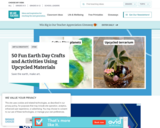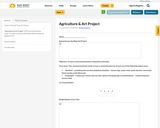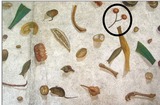
30 crafts you can do at home or school with recycled materials. Get Creative!
- Subject:
- Arts Education
- Visual Arts
- Material Type:
- Activity/Lab
- Author:
- Jessica Mcfadden
- Posted Jessica Mcfadden
- Date Added:
- 06/01/2020

30 crafts you can do at home or school with recycled materials. Get Creative!

This resource gives a diversity of ideas for students to share their writing.

This collection of lesson plans investigates ways artists address political and social issues through their
practice. By carefully examining three works of art from the Chazen’s collection, students will be able
to consider what activism is and how it relates to them and their community. The artwork used in the
curriculum ranges from photographs of schoolchildren exploring their use of language (Ewald) to a
silhouette narrative examining our nation’s fraught history with racism (Walker). The artwork is diverse
in medium, subject, tone, and message. However, several universal themes are present.
The artwork in this collection connects to activism through:
• Addressing histories of oppression
• Considering issues of representation
• Bringing awareness to social and political issues

This site has a series of pre-made free lesson plans that are ready to teach right away. MATH, ELA, SCIENCE, SEL, CAREER, ART, DIGITAL LITERACY, TECH, STEM
They have clips of popular movies and TV shows built right in - and you are allowed to use them bc the site is made by AT
&T and Warner Bros.
"The Achievery helps connect students to a new world of digital learning through stories that spark curiosity and content that entertains as well as teaches."
Don't miss checking this one out! You can use the filters to find exactly what you need.
Copy and paste this url into a browser to watch a short 1 min intro video - https://youtu.be/w-y0u82ps3o
You will have to sign up to access the lessons but it's totally worth it.

Vidéos, matériel audio, visites virtuelles et activités artistiques fournis par le Musée des beaux-arts du Canada pour les classes primaires et secondaires!

Grade 7 Sask Ag Visual Art Project

In this art history video discussion Beth Harris and Steven Zucker look at Albrecht Durer's "Self-Portrait, 1500." (Alte Pinakothek, Munich).

This art history video examines the "Alexander Mosaic" c. 100 B.C.E., tessera mosaic from the House of the Faun, Pompeii. This Roman floor mosaic may be based on a lost Hellenistic painting by Philoxenos of Eretria, The Battle of Issus, c. 315 B.C.E.). Museo Archeologico Nazionale, Naples.

Studied students stupefy! Students learn about alliteration by listening to an alliterative read-aloud and apply the knowledge they gain to the creation of their own poem and illustration.

Students will observe dance movements depicted in a drawing and a painting. Partners will use simple lines to draw their partner's movements and paint dance costumes on the figures using various brushstrokes. Students will write a persuasive speech to the school superintendent explaining why they believe dance should be a regular part of the curriculum. They will then model dance movements for classmates in teams of four and recite their persuasive speech to the class.

Students will analyze and describe a painting depicting a family. They will discuss similarities and differences between the setting of the painting and where they live. Then students will create a sculpture of their family doing an activity together and also create a diorama of a room in their home.

In this art history video discussion Beth Harris and Steven Zucker examine Albrecht Altdorfer's "The Battle of Issus," 1529, oil on panel. Alte Pinokothek, Munich.

In this art history video discussion Dr. Beth Harris and Dr. Steven Zucker consider Ambrogio Lorenzetti's series of frescos "Allegory of Good Government", "Effects of Good Government in the City and the Country", and "Allegory and Effects of Bad Government in the City and the Country" Siena c. 1337-40. Sala della Pace (Hall of Peace) also known as the Sala dei Nove (the Hall of the Nine), Palazzo Pubblico, Siena.

Students apply the analytical skills that they use when reading literature to an exploration of the underlying meaning and symbolism in Hieronymous BoschŐs early Renaissance painting "Death and the Miser".

This resource outlines the Ancient Greek art form, Trompe L'Oeil. Several resources are provided to learn more about this concept. Links for realistic drawing tutorials from Art for Kids Hub are also included.

This resources includes a couple of Ancient Greek Vase Project ideas. Vases and jugs were a very popular Ancient Greek art form.

Children’s drawings have a wonderful inventiveness, energy, and variety.
Bring children's drawings to life by animating characters to move around!

We know that the everyday lives of our students are inundated with media. This often-overwhelming menu of media-rich entrées gets served up at a rate that seems to value overconsumption more than proper and meaningful digestion. As educators, we may be left wondering, how do we beef up (or tofu up , if you prefer) our students’ appetites for media-literacy so that they can skillfully navigate our ever-changing, media-saturated landscape?

This instructional program prepares students to use artistic and technological foundations to create animated presentations for industry and entertainment. Students will develop basic drawing and design skills, learn the fundamentals and physics movement, the concept of communication to a given audience, and techniques for self-expression through a variety of animated formats. They will explore the careers and requisite skills required by animators in both entertainment and the business world.

This site explores the elements of art and principles of design with videos, examples and lessons.
The elements and principles of design are the building blocks used to create a work of art.
Elements of Art are the visual "tools" that artists use to create an art work - they are what makes up an image or an art object: line, shape/form, value, color, space, and texture.
Principles of Design are the ways artists use the Elements of Art in an artwork - this is "what we do with the Elements" - how we arrange them, how we balance them, what is being emphasized, etc. The principles are: balance, contrast, repetition, emphasis, and unity.
Be sure to check out Art 2 - Lesson plans for intermediate Art program @ https://resourcebank.ca/courses/art-1-lesson-plans-for-beginner-art-program